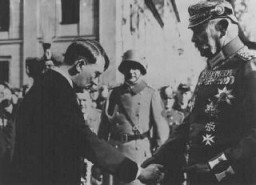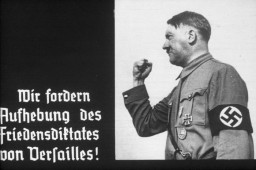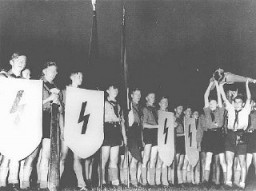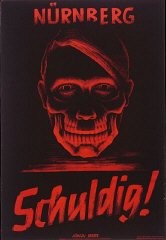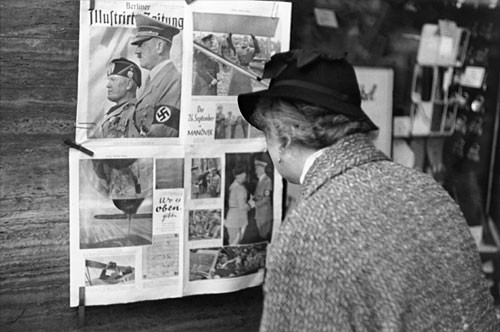
Writing the News
Shortly after taking power in January 1933, Adolf Hitler and the Nazis succeeded in destroying Germany’s vibrant and diverse newspaper culture. The newly created Ministry of Public Enlightenment and Propaganda handed out daily instructions to all German newspapers, Nazi or independent, detailing how the news was to be reported.
-
1
Prior to the Nazi takeover, Germany had 4,700 different newspapers, reflecting all shades of political opinion.
-
2
The Nazi regime quickly eliminated freedom of the press in Germany, shutting down oppositional newspapers and manipulating the press.
-
3
The Nazi Party’s press empire rapidly expanded after 1933, as did the readership of its newspapers. The Nazi press accounted for more than 80% of the newspapers circulated in Germany by mid-1941.
Introduction
Reflecting in his diary (April 14, 1943) during the war on the press's loss of independence, Joseph Goebbels, a one-time journalist, wrote: "Any man who still has a residue of honor will be very careful not to become a journalist."
When Hitler came to power in 1933, Germany had a well-developed communications infrastructure.
Over 4,700 daily and weekly newspapers were published annually in Germany, more newspapers than in any other industrialized nation, with a total circulation of 25 million. Although Berlin was the press capital, small town presses dominated newspaper circulation (81% of all German newspapers were locally-owned). Eight papers published in larger cities, however, had established international reputations.
Germany's movie industry ranked among the world's largest, its films had won international acclaim, and it had pioneered in the development of both radio and television.
Establishing Control of the Press
When Hitler took power in 1933, the Nazis controlled less than three percent of Germany's 4,700 papers. The elimination of the multiparty political system not only brought about the demise of hundreds of newspapers produced by outlawed political parties; it also allowed the state to seize the printing plants and equipment of the Communist and Social Democratic Parties, which were often turned over directly to the Nazi Party. In the following months, the Nazis established control or exerted influence over independent press organs.
During the first weeks of 1933, the Nazi regime deployed the radio, press, and newsreels to stoke fears of a pending “Communist uprising,” then channeled popular anxieties into political measures that eradicated civil liberties and democracy.
Within months, the Nazi regime destroyed Germany's previously vigorous free press. By 1941, the Nazi Party's Eher publishing house had become the largest ever in German history, and its main daily newspaper, the Völkischer Beobachter (People's Observer) had reached a circulation of over 1,000,000.
The Völkischer Beobachter, which Hitler had purchased for the party in 1920, announced meetings and other news to members and extended the party's reach beyond the beer hall and Party gathering. Circulation rose along with the success of the Nazi movement, reaching more than 120,000 in 1931 and 1.7 million by 1944.
Edited by the antisemitic writer and Nazi ideologue Alfred Rosenberg, the Völkischer Beobachter specialized in short hyperboles of favorite Nazi themes: the humiliation of the Versailles Treaty, the weakness of Weimar parliamentarianism, and the evil of world Jewry and Bolshevism, all of which were contrasted with Nazi patriotic slogans.
One Man, One Paper
Der Stürmer was the most notorious, antisemitic newspaper in Germany. Nazi provincial leader [Gauleiter] Julius Streicher, a former schoolteacher turned Nazi activist, edited and directed the paper.
The newspaper ran for more than 20 years, from 1923 to 1945, publishing lurid tales of Jewish “ritual murder,” sex crimes, and financial malfeasance. During the Weimar Republic, the outrageous and libelous claims of Der Stürmer frequently resulted in lawsuits filed by outraged politicians and Jewish organizations against Streicher himself and the newspaper.
Following the Nazi takeover, however, the fortunes of the paper and its editor skyrocketed. Circulation dramatically increased from 14,000 in 1927 to almost 500,000 in 1935. Though foreign visitors and many Germans, including some Nazi propagandists, found the one-topic newspaper offensive, Hitler refused to close down Der Stürmer, even after a Nazi Party Court stripped Streicher of his political and Party offices because of corruption.
During the 1930s, Germans could find Der Stürmer on sidewalks and street corners throughout Germany. Streicher set up numerous display cases to promote his antisemitic propaganda and increase circulation. To fill all these display boxes and subscriptions, he sometimes increased print runs of the newspaper to 2,000,000.
Jewish Newspapers as Communal Response
Even as the Nazi propaganda machine hijacked the German press in service of its racist ideology, newspapers published by local Jewish communities (Gemeinden) for their members became a life-line for Jews in towns and cities across Germany and a link between local communities and the leaders of Jewish national organizations.
After the nation-wide boycott of Jewish businesses in April 1933, Arno Herzberg, bureau chief of the Jewish Telegraphic Agency in Berlin, wrote:
“The new circumstances in which German Jewry now finds itself have also heralded a new era for the Jewish press. This new era has ushered in far-reaching tasks for Jewish journalism. Beforehand, the Jewish press led a quiet existence. It was peripheral to the concerns of the average German Jew … All this has changed fundamentally in the era in which Jews are excluded from broad German intellectual and social circles.”
These communal newspapers published articles and editorials meant to strengthen a positive Jewish identity in the face of degrading official antisemitic propaganda, and to provide the members of the community with advice and encouragement for meeting the daily challenges created by life under the Nazi anti-Jewish legislation. As more and more Jews emigrated from Germany, many smaller Gemeinden disappeared and their newspapers closed. On November 11, 1938, following the violence of the Kristallnacht pogrom, the German government forbade the remaining Jewish communal newspapers to publish. Jews now had to receive all news and official announcements from the government-controlled Jüdisches Nachrichtenblatt.
German authorities did not require Jewish communal newspapers to adhere to the regulations imposed on the German press at large. For instance, Jewish publications were not obligated to publish word for word the talking points or repeat the official propaganda issued by the Ministry of Propaganda at its daily press conferences. German authorities did forbid non-Jews either to purchase or read these Jewish communal newspapers.
New Avenues for Propaganda: Film, Radio, Television
The Nazis understood the power and attraction of emerging technologies, such as film, loudspeakers, radio, and television, in the service of propaganda. These technologies offered the Nazi leadership a means for mass dissemination of their ideological messages and a vehicle for reinforcing the myth of the Volksgemeinschaft (National Community) through communal listening and viewing experiences.
After 1933, German radio broadcast Hitler's speeches into homes, factories, and even onto city streets through loudspeakers. Officials in Goebbels' Ministry of Propaganda saw the tremendous promise of radio for propaganda. The ministry heavily subsidized the creation of the inexpensive “People's Radio” (Volksempfänger) to facilitate sales. By 1935, about 1.5 million of these radios were sold, giving Germany one of the largest radio-listening publics in the world.
In 1935, Germany became the first nation to introduce regular television service. Minister of Propaganda Joseph Goebbels saw the great propaganda potential of the new medium, but believed it was best experienced through collective viewing, like the cinema or theater.
Behind the Headlines: Nazi Media Manipulation—Kristallnacht
On the night of November 9/10, 1938, Nazi leaders instigated a wave of violence that devastated Jewish communities throughout the Greater German Reich and outraged world opinion. At the urging of Propaganda Minister Joseph Goebbels, local and regional Nazi leaders engaged in wanton destruction and brutality, using the assassination of a German diplomat in Paris by an angry Jewish teenager to justify the violence. On Kristallnacht (the Night of Broken Glass), rioters damaged or destroyed some 7,500 Jewish businesses, torched hundreds of synagogues, and murdered 91 Jews.
During the following days, the German Security Police arrested up to 30,000 Jewish men and incarcerated them in Buchenwald, Dachau, and Sachsenhausen concentration camps.
Even as newspapers around the world reported on the events and consequences of Kristallnacht, the German Propaganda Ministry's engaged in serious damage control through a stage-managed media campaign that sought to justify the passions behind the violence by attributing it to “spontaneous outrage” of the German people, and to minimize the actual scale of the death and destruction.
The behind-the-scenes press manipulation surrounding this event reveals the information- and damage-control operations of the Nazi propaganda machine (to both the German and international public) and how quickly it responded to outside criticism and breaking news.
Forbidden Broadcasts: Foreign Radio as an Alternative Source of News
During times of war, governments generally restrict and censor public access to information in order to prevent sensitive data leaking to the enemy or to isolate the domestic population from information that might undermine public morale. After Germany invaded Poland on September 1, 1939, the Nazi regime implemented draconian measures to prevent its population from receiving outside information. The German government prohibited its citizens from listening to foreign broadcasts. Doing so became a criminal offense. German courts could sentence persons who disseminated stories from enemy radio stations to prison terms or even death.
Guided by fears that Allied propaganda in World War I had eroded German morale and encouraged unrest, German authorities hoped that the threat of severe punishment for listening to foreign broadcasts would reinforce efforts to insulate the population from enemy “lies.” In spite of the watchful eyes and ears of Gestapo and Nazi Party informants, millions of Germans tuned in to the British Broadcasting Corporation (BBC) and other forbidden broadcasting stations to gather information.
Critical Thinking Questions
- What political messages, delivered through propaganda, often occur as a nation moves toward genocide?
- What techniques and approaches seemed to be the most effective for the Nazi regime? What techniques and approaches seem to be effective for modern governments?
- How can citizens “protect” themselves (and their nation) from propaganda in all of its forms? What institutions in a country could be involved in this effort?


